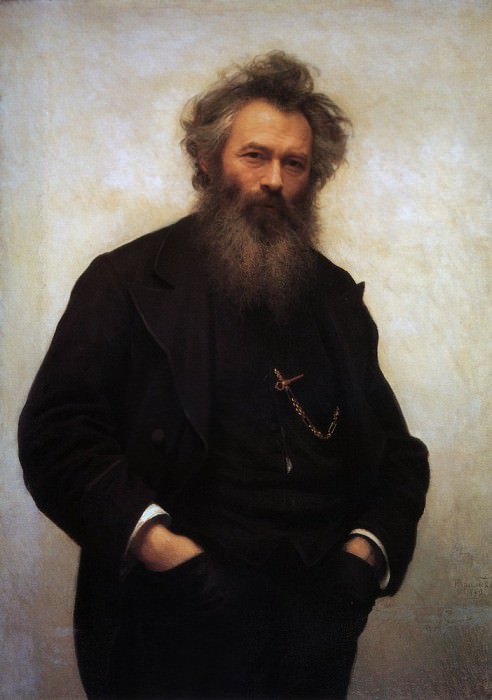Portrait Shishkin 1880 115. 5h188 Ivan Ivanovich Shishkin (1832-1898)
Ivan Ivanovich Shishkin – Portrait Shishkin 1880 115. 5h188
Edit attribution
Download full size: 702×1000 px (0,1 Mb)
Painter: Ivan Ivanovich Shishkin
Ivan Kramsky’s portraits were born from the technique of retouching photographs. The future painter wandered around Russia and sketched photographic portraits, learning at the same time the laws of light and volume. In St. Petersburg he finally gained fame as a superb retoucher. He dared to pass the exams for the Imperial Academy of Arts without preparation and was successfully enrolled among the students and the most famous artists of the era. After the rebellion that arose as a result of his protest against the academic order, Kramskoy and his associates organized an Artel of painters with a free choice of subjects, followed by traveling exhibitions.
Description of the painting "Portrait of Shishkin" by Ivan Kramskoi
Ivan Kramsky’s portraits were born from the technique of retouching photographs. The future painter wandered around Russia and sketched photographic portraits, learning at the same time the laws of light and volume.
In St. Petersburg he finally gained fame as a superb retoucher. He dared to pass the exams for the Imperial Academy of Arts without preparation and was successfully enrolled among the students and the most famous artists of the era.
After the rebellion that arose as a result of his protest against the academic order, Kramskoy and his associates organized an Artel of painters with a free choice of subjects, followed by traveling exhibitions. The portrait painter’s talent manifested itself with greater certainty and power in the second half of the 19th century. He became a fashionable artist and was awarded the title of academician.
Kramskoy was commissioned by Tretyakov to paint a series of portraits to create a gallery of outstanding Russian people, among whom appears a portrait of the landscape painter Shishkin. We can see the real faces of people who brought glory to Russia and played a role in the history of art.
Kramskoy was friends with Shishkin and was his ideological inspirer. Ivan Kramskoi’s realistic, almost photographic paintings tell us about the fates of the era. Kramskoy portrayed Shishkin twice.
His portrait, painted in 1880, is a truthful and wholesome image of the landscape painter. The viewer sees a contemporary of Kramsky, who has just married for the second time. The large figure stares calmly out of the canvas. His big hands do not fit into his pockets.
His open high forehead betrays a master with a kind character, which is quite in line with the verbal descriptions of his colleagues, who spoke of him as harsh only in appearance. He was judged by his Great Russian appearance as a parish foreman, in fact, who belonged to a fine art.
Kramskoy portrayed him as the "master of the forest and poet of nature" - a tall, handsome, strong man with a penetrating look and a bushy beard.
Кому понравилось
Пожалуйста, подождите
На эту операцию может потребоваться несколько секунд.
Информация появится в новом окне,
если открытие новых окон не запрещено в настройках вашего браузера.
You need to login
Для работы с коллекциями – пожалуйста, войдите в аккаунт (open in new window).




















COMMENTS: 4 Ответы
Если бы этот портрет написал сам Шишикин, то он бы назывался Автопортрет! А на писал его Крамской И. Н. в 1880
Bar_BQ, вы отлично знаете русскую живопись, искреннее спасибо за помощь в устранении неточностей!
чудесно, привасходно, прикрасно!
А ведь на этом портрете Ивану Ивановичу ещё нет и 50-ти лет... Интересно сравнение этого портрета с автопортретом от 1854года. Как же быстро старились люди в те времена...
You cannot comment Why?
The subtexts of this portrait revolve around the artists persona and his connection to nature. Shishkin was renowned for his detailed and realistic landscapes, often depicting the Russian forest. His unkempt appearance in this portrait could symbolize his immersion in and dedication to his art, perhaps even suggesting a wildness or ruggedness that mirrored the natural landscapes he painted. The direct, unwavering gaze might indicate his intense focus and artistic vision. The casual stance, with hands in pockets, could be interpreted as a humble yet confident portrayal of a successful artist, unburdened by pretension, whose true expression lies in his work rather than his outward appearance. The painting captures an essence of the artist as a sensitive, dedicated soul deeply connected to the untamed beauty of the natural world.